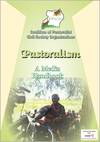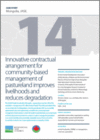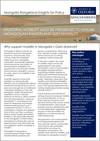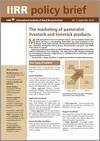This media handbook provides a quick reference guide that can be used by journalists and other media practitioners to help influence perceptions, policy and practice related to pastoralism among Ugandan policymakers and the general public. It describes in an easily understandable way what pastoralism is, why it is important, the challenges that pastoralists face, and the role that media can play in dispelling myths about pastoralism and portraying its reality.
Year of publication: 2015Organization: Coalition of Pastoralist Civil Society Organisations (COPACSO)
Topic: Social services
Language: English
Type of document: Technical
Geographical coverage: Eastern Africa
The 200,000 herder households of Mongolia manage around 45 million livestock heads. The public pasturelands they use are at high risk of soil degradation. Over the past decade, the local NGO Environment and Development Association “JASIL” has successfully experimented with, and implemented, a model for the community-based management of pastureland, in which the herder households, their community heads, and the local governments enter into contract, in order to manage the pastureland in an environmentally and economically sustainable manner. The income of the households involved in the 10-year experimentation increased by 23-56%.
Year of publication: 2014Organization: International Land Coalition (ILC)
Topic: Land
Language: English
Type of document: Technical
Geographical coverage: Central Asia
This video shows some of the main challenges of the Raikas, a semi nomadic community in Rajasthan, India and how ICARDA responds to them. Change of land use, climate change and little social recognition for mobile livelihoods make it harder for the Raikas to find water and pasture.
Year of publication: 2014Organization: Individual authors
Topic: Climate change, Economy, Land
Language: English
Type of document: Videos
Geographical coverage: South Asia
This study focuses on pastoralism’s current and future potential for securing sustainable management and green economy outcomes from the world’s rangelands. It synthesises existing evidence and uses practical examples from mobile pastoralism in Europe, Latin America, North America, Central, Western and Southern Asia, Australia and throughout Africa to both demonstrate the system’s inherent characteristics for adaptive sustainability and some of the key opportunities and challenges for promoting development in rangelands. Finally, the study identifies the key enabling conditions required for pastoralism to deliver on its potential role in a Green Economy.
Year of publication: 2014Organization: International Union for Conservation of Nature (IUCN), United Nations Environment Programme (UNEP)
Topic: Economy, Environmental services
Language: English, Français, Español
Type of document: Technical
Geographical coverage: Global
Large-scale land acquisitions have increased in scale and pace. The areas most affected are the global “commons” – lands that local people traditionally use collectively — including much of the world’s forests, wetlands, and rangelands. In some cases land acquisition occurs with environmental objectives in sight – including the setting aside of land as protected areas for biodiversity conservation. There is a potential opportunity here for greater collaboration between conservation interests, and local communities’ land rights interests with their supporters amongst human rights and social justice movements. This issue paper documents experiences from the rangelands of Mongolia, Kenya, India, Ethiopia, and other countries.
Year of publication: 2014Organization: International Land Coalition (ILC)
Topic: Land
Language: English
Type of document: Technical
Geographical coverage: Global
This study explores the nature of ecosystem services provided by livestock species and breeds, with special consideration to the important contributions to these by small-scale livestock keepers and pastoralists. Livestock species and breeds are key components of agro-ecosystems. They provide provisioning services (such as the supply of food, fibres and skins), supporting and regulating services (such as waste recycling or weed control) and cultural services (such as cultural heritage and identity). The study describes the most serious constraints and opportunities to the provision of ecosystem services. It identifies international instruments and bodies that support and can further promote the actual and potential roles of livestock species and breeds, as well as their keepers in the provision of ecosystem services.
Year of publication: 2014Organization: Food and Agriculture Organization of the United Nations (FAO)
Topic: Environmental services
Language: English
Type of document: Technical, Scientific
Geographical coverage: Global
Pastoral mobility must be preserved to ensure Mongolian rangeland sustainability. Pastoralism in Mongolia is currently going through major transformations (pasture user groups, cooperatives, draft Land Law, climate change, conflicting forms of land use i.e. mining, cropping, national reserves). In this new context, the value of mobility might not be fully appreciated in new policy formulations, which could weaken Mongolian pastoral systems. Supporting mobility requires an adequate institutional framework in the provision of services (e.g. water, veterinary, education and health) and institutional flexibility with stronger and reciprocal intersoum inter-aymag agreements for hosting neighboring herders during climate shocks.
Year of publication: 2014Organization: University of Oxford
Topic: Organization
Language: English
Type of document: Policies and legislation
Geographical coverage: Central Asia
This brief lists a range of policies to support pastoralists to market their products.
Year of publication: 2014Organization: International Institute of Rural Reconstruction (IIRR)
Topic: Economy
Language: English
Type of document: Technical, Policies and legislation
Geographical coverage: Eastern Africa









